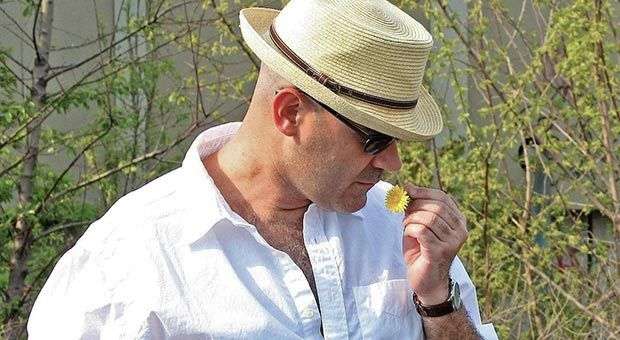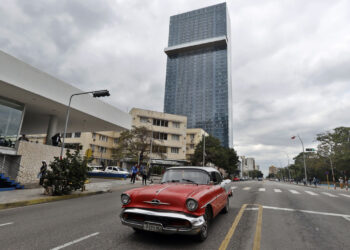Soon the Cuban audience will have the opportunity to come closer to a new stage in Fernando Perez cinematography. His film, Madrigal, was an approach to difficulties in the artistic universe; José Martí: el ojo del canario, revealed an unexplored dimension of an eternal Cuban myth; and La pared de las palabras deals with a grieving family for the loss of their only child behind the white walls of a mental institution. OnCuba talked to Erick Grass, the artist behind each of the universes, environments and images that make up these stories.
How was your creative initiation with Fernando Perez?
I worked with Jorge Luis Sánchez in El Benny. This film got some recognition, including the Caracol award, among others. It seems Fernando heard about me and when I was preparing Madrigal and he called me. I was stunned. He had asked Jorge Luis or a member of the team for my telephone number because he wanted to get in touch with me. He told me he wanted to make a contrived movie based on dramas and parallel universes… And right away I visualized what he was asking for the movie.
When we started working together I once again ran into Raúl Pérez Ureta –Thanks God!– in photography. He is Fernando’s most faithful collaborator and I had done a lot of movies with Ureta.
What can you say about working with Fernando and Ureta?
Working with Fernando was a very creative and enriching experience because he is a young and free spirit who is ok with going up the stairs of a 50 floor building or taking a lift that is about to fall. He went with us everywhere. On the other hand, working with Raúl Pérez Ureta, who is also of advanced age, was exactly the same. We found very odd locations in Havana; which had never been shot before or that had been shot differently than for this film.
You had also worked with Arturo Sotto, Jorge Luis Sánchez and Humberto Solás, what does it mean for you to work with Fernando?
By then, I had read a book by Mercedes Santos Moray (La vida es silbar) that kept me really nervous. The author said that Fernando used to talk about the team he had always worked with: Raúl Pérez Ureta, in photography, Julia Yip Nodarse, in editing, and Edesio Alejandro Rodríguez, in music. However, he personally used to say that he hadn’t found his homologue for art direction, someone he could work with. I was really scared about that because I had Damocles’ sword pointing at my neck…
This is Fernando Perez first digital movie, how much influence do you consider this format had as to art direction?
I was positively surprised by Madrigal’s digital image. I had previously produced a digital film with Humberto Solas: Miel para Oshun; but it didn’t demand too much aesthetics and artistic values mainly because it was a plain narration of the Cuban reality at that time.
Nonetheless, when we produced Madrigal the digital became a means of expression rather than an alternative. Madrigal’s image is shocking. I was stunned when I saw it at the Chaplin movie theater. I told myself: My God, it looks incredibly fine! I was surprised with the photography by Raul, who helped me a lot and expanded my work. I was surprised mostly for the quality achieved by means of digital photography, which many used to describe negatively. Madrigal conveys an underlying artistic knowledge that we talked about since its beginning. Fernando precisely outlined the course to follow. He used to say: “I want to make a different movie in terms of aesthetics”. The plot of the film is also different, it is oblique.
How much do you have to thank the art direction created in Madrigal?
I suggested Fernando about certain artistic formats that would contribute with avoiding excessive chromiumin order to move towards an atonal film. He liked this idea a lot; he also wrote down in his diary: “it must be an atonal film, non-chromatic, on a grey color scale”. We created a bizarre universe that is present in the film. Drama also played an important role in the film, under the direction of Carlos Diaz. He organized the crowd of young actors all dressed the same, monks, men in grey, which contributed with Madrigal’s shocking result. I think of it as a work of art. I like it a lot, though more than a few were not trapped by it.
You also undertook the art direction in José Martí: el ojo del canario…
Yes, as time went by Fernando called me for José Martí: el ojo del canario. Then, I said: “The myth that he didn’t work with the same art director was broken” because he called me again. We began working in the film, which was very important given the consequences of telling a story about the mythical figure of Jose Marti and because there were several documentaries or films about him with more or less success. Generally speaking, the image of the Cuban Hero hadn’t flourished. That’s the reason why, Fernando came up with the idea of approaching him from less known aspects. For that, the story ends when the young man is about to leave for Spain after his political imprisonment.
How successful was this idea in the creative process?
It was successful because we wouldn’t have the audience criticizing us: “that’s not Marti, that’s not what I was taught at school”. Fernando was not interested in in telling Marti’s story, but in telling the story of a boy from the 19th century with a revealing way of thinking that would change a reality. This kid might as well be José, Ramón, Manolo, anyone. It was Marti’s story, but it goes beyond his family and tackles the Cuban reality of the 19th century.
Then, the art direction followed the natural courses of history…
Fernando was interested in rescuing the sense of daily routine from an epoch comprised below museum plaques. Thus, we faced the need to follow that same line. The image of the city had to be dirty. Havana was not paved until the 20th century. We consulted pictures from the early past century; there were dirt roads, pure mud. And that’s portrayed in the film.
It was really interesting for us to develop a faithful image of the epoch. We wanted to produce a film with as many traits from the 19th century as possible. In that sense, we made the most of the information gathered from magazines and journals from that time and in letters by Marti’s family, where they talked about so simple things that made us wonder: “how is it possible that in the 19th century people would talk that way and about such topics?”
Has Fernando called you again?
Yes, the last film I did with him was La pared de las palabras which has not been released yet. This is the third one… so, perhaps he invites me for the fourth one, but for the third one he did call me! The film has not been premiered yet because of some issues in its production and postproduction. This is an independent movie which sometimes brings about troubles or some kind of comfort at work.
Can you give some advances of the film for OnCuba´s readers?
It is a daily film that tackles a tough issue. It is a short story about a family and their issues. The risks were in trying to tell a story like this one in a real and natural space. La pared takes place in two basic spaces: a mental institution in Havana and the home of a family with a child in that institution. The house of the main character, Isabel Santos, is located in Santa Fe, among other things, because she has to do with oceanology. Therefore, constant contact with the sea was necessary.
Then, the sea plays an important role again as in La vida es silbar, Habana Suite…
Fernando is talented in making poetry with images. I wanted the sea to offer a world of peace for the main character to escape the sad world, its reality, that of having a sick child for so many years.
In your opinion, what’s the advantage for the art direction of being independent?
This gave me freedom to choose the team I would work with. I called two young set designers with whom I work in Los dioses rotos, by Ernesto Daranas. These two boys have been excellent. In Los dioses rotos they were invited by the Cuban Film Institute (ICAIC by its acronym in Spanish), which produced the movie. It was like love at first sight. They were really good, and they have an incredible work capacity. They not only looked for materials but they also designed them.
Luckily, we also worked together in La pared de las palabras, and I assure you it wasa success. The team I chose for set design work at an incredible pace and they showed they mastered their specialty. It was a success.
And with Fernando Perez?
Once again, Fernando trusted in my aesthetic decisions. In the three movies we have produced we have had no arguments. In La pared de las palabras I gave him a few suggestions on the cast and the lighting. There was a scene of a meal they wanted to have outdoors, in Santa Fe beach. The sun was really hot, and two actresses, Isabel Santos and Veronica Lyn, had to work on the sun and they both have really white skins. Then, we did some sort of pergola. Fernando at first questioned it: a pergola, why? Then I said to him: “look, I can make it look old so that everything seems deteriorated”. And we made it and I also helped actresses to tinge light.
In general, I can tell you that working with him has been excellent. He always listens to what I have to say. He does the same with cloth designers and he thoroughly analyzes each piece. He loves live, worn clothes. He doesn’t like recently bought clothes. He wants everything to old, sweaty.
Are you satisfied with the results?
Yes, the three movies by Fernando Perez where I have worked have been really solid. He has full domain of aesthetic and theater resources of his cinema. I haven’t seen a single fragment of La pared de las palabras… He hasn’t called me to see any of it. He always does the same; he leaves me like this till the end! It is the same for the actors; they only get to see the scenes they recorded. But Edesio Alejandro has seen it all because he is in charge of the soundtrack of the movie.
So, Edesio Alejandro Rodríguez is in charge of the music of the film?
He is in charge of the soundtracks, because in this film as well as in Jose Marti…, Fernando is thinking on a kind of cinema in which music is random. He would rather focus on drama, which somehow amplifies natural sounds. In Jose Marti there are only two tracks: Casta Diva by Barbara Yanez and a piano version of La Bayamesa in the credits. The rest is all about environmental sounds. In this movie, Fernando wanted to do the same. He uses the sounds of the sea, the yelling of sick people, whose sonority enriches the story.
I don’t think Edesio will write music for the film. He will actually do a postproduction work, where he will do specific music by using environmental sounds.
I assure you the film is solid. The cast was carefully chosen: Isabel Santos, Verónica Lynn and Jorge Perugorría, who plays the role of Isabel Santo’s child.
Perugorría plays the role of Isabel Santos’s son?
The character suffers from dystonia, a mental disease with a repercussion in the physical aspects of the patient. Generally, sick people deteriorate a lot. Even if they are properly cared for and bathed daily, they gradually deteriorate due to the medications they take and the negative effects of the disease. In this sense, this character can perfectly look as old as his mother.
Personally, Fernando is very close to this film. He has been touched by that image of joy people try to keep regardless of their many problems. I just recalled Aurora Basnuevo and Mario Limonta, whose only son is at the Quinta Canaria, the hospital where we did the shooting. They have managed to develop their artistic career, a life of their own, and joy… They are capable of sharing all that with people, but they have had that burden in their shoulders for a long time. Fernando has had to endure his own burden, but he has been capable of making a kind of cinema where everyone can identify himself.
For Fernando La pared de las palabras represented a chance to dialogue with a reality they are close to, which is told by other characters, with an ending that is not based on its immediate reality. But I’m not going to tell you the end…
Somehow, La pared de laspalabras makes you reflect as a regular man on the difficult realities around you, which one sometimes forget. From the human point of view, the movie conveys development and personal achievement paradigms. I haven’t seen the final edition of the movie but based on the script I dare to say it is a really tough and attractive film.










